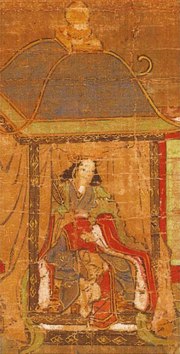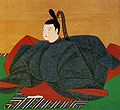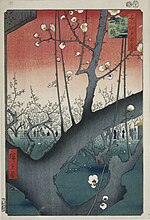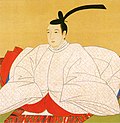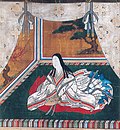Okiko (Japanese: 興子), posthumously honored as Empress Meishō (明正天皇, Meishō-tennō, January 9, 1624 – December 4, 1696), was the 109th monarch of Japan,...
14 KB (1,266 words) - 14:54, 12 July 2024
Meisho (名所, lit. 'famous places') originally referred to sites in Japan famous for their associations with specific poetic or literary references. With...
4 KB (542 words) - 15:33, 26 July 2024
The Meishō Line (名松線, Meishō-sen) is a rural, regional railway line of Central Japan Railway Company (JR Central) in Mie Prefecture, Japan, connecting...
7 KB (417 words) - 15:05, 9 January 2024
retaining to the emperors of Japan, the term Meishō Tennō can be seen for female rulers rather than Meishō Josei Tennō. Josei Tennō is only used to differentiate...
17 KB (1,958 words) - 23:24, 30 July 2024
Owari meisho zue (尾張名所図会, “Guide to famous Owari sites”) is an illustrated guide describing famous places, called meisho, and depicting their scenery in...
2 KB (98 words) - 15:27, 28 March 2024
Meisho Mambo (Japanese: メイショウマンボ, foaled 25 February 2010) is a Japanese Thoroughbred racehorse who won the second and third legs of the Japanese Fillies'...
13 KB (1,374 words) - 15:45, 26 December 2023
raised as if he were the son of Tōfuku-mon'in. His predecessor, Empress Meishō, was his elder paternal half-sister. Go-Kōmyō's Imperial family lived with...
12 KB (1,057 words) - 14:55, 12 July 2024
literature (such as Matsuo Bashō’s haiku) that mention it. In overall scope, Edo Meishō Zue goes beyond the confines of the Edo proper and includes descriptions...
5 KB (589 words) - 21:13, 13 November 2023
Tōsha Meishō (藤舎名生) (born 1941) is a Japanese hayashi musician, one of a long line of Tōsha school musicians specializing in providing musical accompaniment...
3 KB (205 words) - 06:49, 2 March 2024
Sanoyas Hishino Meisho Corporation is a Japanese company that consists of four principal business groups and twelve affiliated companies. The business...
12 KB (894 words) - 23:20, 12 September 2024
One Hundred Famous Views of Edo (redirect from Meisho Edo Hyakkei)
volume illustrated guidebook Pictures of famous places of Edo (江戸名所図会, Edo meishō zue) was published. It was begun by Saitō Yukio (1737–1799) in 1790 and...
71 KB (937 words) - 00:35, 30 July 2024
Meisho Samson (Japanese : メイショウサムソン, March 7, 2003 - ) is a Japanese racehorse which won the Tokyo Yūshun and Satsuki Sho in 2006, and the Tenno Sho (Spring...
3 KB (52 words) - 15:46, 26 December 2023
Princess Okiko (興子内親王, 9 January 1624 – 4 December 1696), later Empress Meishō Third Daughter: Princess Onna-ni (女二宮, 14 October 1625 – 2 July 1651), Legal...
17 KB (1,732 words) - 14:54, 12 July 2024
succeeded her father. She ascended the Chrysanthemum Throne as Empress Meishō. Meishō would be succeeded by two of her half-brothers, who would later become...
6 KB (600 words) - 15:48, 12 July 2024
Edo-no-Hana Meisho-e is a rare antique Japanese woodblock print art series. The title of the Ukiyo-e print series Edo-no-Hana Meisho-e translates into...
10 KB (1,415 words) - 12:58, 4 November 2022
this empress's immediate Imperial predecessors since Emperor Go-Mizunoo – Meishō, Go-Kōmyō, Go-Sai, Reigen, Higashiyama, Nakamikado, Sakuramachi and Momozono...
15 KB (1,455 words) - 05:56, 12 July 2024
1603–1868 Go-Yōzei Go-Mizunoo Meishō Go-Kōmyō Go-Sai Reigen Higashiyama Nakamikado Sakuramachi Momozono Go-Sakuramachi Go-Momozono Kōkaku Ninkō Kōmei Meiji...
71 KB (4,392 words) - 22:51, 13 September 2024
Shinto shrine (section Meishō)
is the shrine's name proper, or meishō (名称), the second is the so-called shōgō (称号), or "title". The most common meishō is the location where the shrine...
82 KB (9,508 words) - 14:58, 9 September 2024
Station 59.9 km Kisei Main Line: Kameyama Station—Shingū Station 180.2 km Meishō Line: Matsusaka Station—Ise-Okitsu Station 43.5 km Sangū Line: Taki Station—Toba...
16 KB (1,126 words) - 08:18, 4 September 2024
armed Buddhist monks were common during the sengoku period. The Empress Meishō (r. 1629–43) also had grave doubts when she heard about how the Spanish...
35 KB (4,527 words) - 09:17, 15 September 2024
reigning after Kōgyoku/Saimei were Jitō, Genmei, Genshō, Kōken/Shōtoku, Meishō, and Go-Sakuramachi. Before her ascension to the Chrysanthemum Throne, her...
14 KB (1,401 words) - 14:01, 12 July 2024
A Japanese vendor selling sweets (wagashi) in "The Great Buddha Sweet Shop" from the Miyako meisho zue (ja:都名所図会) (1787)...
34 KB (3,447 words) - 17:24, 10 September 2024
a girl, eventually succeeded to the throne of Japan to become Empress Meishō. The city of Edo was also heavily developed under his reign. Historian Michifumi...
21 KB (1,627 words) - 20:38, 13 September 2024
previous emperors' posthumous names: Empress Genmei + Empress Genshō → Empress Meishō Empress Shōtoku + Emperor Kōnin → Emperor Shōkō Official posthumous names...
25 KB (2,966 words) - 19:18, 19 August 2024
specifically one that brings back childhood memories. Akisato Ritō's Miyako meisho zue (An Illustrated Guide to the Capital) from 1787 describes a confectionery...
6 KB (490 words) - 07:39, 20 May 2024
this Emperor's immediate Imperial predecessors since Emperor Go-Mizunoo – Meishō, Go-Kōmyō, Go-Sai, Reigen, Higashiyama, Nakamikado, Sakuramachi, Momozono...
16 KB (895 words) - 21:50, 14 August 2024
Masako (Hidetada's daughter and Iemitsu's sister), and Imperial Princess Meishō in Kyoto. Shōgun Iemitsu made lavish grants of gold and money to the court...
20 KB (2,416 words) - 12:57, 13 August 2024
Suiko, Kōgyoku, Jitō and Genmei; the three reigning after her were Kōken, Meishō, and Go-Sakuramachi. Before her ascension to the Chrysanthemum Throne, her...
12 KB (1,185 words) - 20:37, 29 July 2024
remained strictly traditional; themes of landscapes (fukeiga), famous places (meishō), beautiful women (bijinga), kabuki actors (yakusha-e), and birds-and-flowers...
13 KB (1,667 words) - 22:24, 2 September 2024
A Japanese tourist consulting a tour guide and a guide book from Akizato Ritō's Miyako meisho zue (1787)...
98 KB (11,537 words) - 13:16, 5 September 2024



